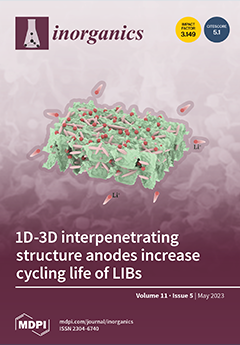The carbonation behavior of calcium-containing sorbents, CaO and Ca(OH)
2, was investigated under pressurized CO
2 at nominal room temperature. The carbonation reaction was mechanically driven via reactive ball milling. The carbonation rate was determined by monitoring the CO
2 pressure inside
[...] Read more.
The carbonation behavior of calcium-containing sorbents, CaO and Ca(OH)
2, was investigated under pressurized CO
2 at nominal room temperature. The carbonation reaction was mechanically driven via reactive ball milling. The carbonation rate was determined by monitoring the CO
2 pressure inside the sealed milling jar. Two different versions of CaO were fabricated as starting materials. The addition of citric acid in CaO synthesis resulted in a significant increase in sorbent surface area, bringing up the conversion of CO
2 from 18% to 41% after 3 h of reactive milling. The hydroxide formation from these two oxides closed the surface area gap. Nevertheless, we found that hydroxides had a higher initial carbonation rate and greater final CO
2 uptake than their oxide counterparts. However, the formation of byproduct water limited the further carbonation of Ca(OH)
2. When we added a controlled amount of water to the CaO-containing milling jar, the highest carbonation rate and most extensive CO
2 uptake were attained due to the in situ formation of reactive Ca(OH)
2 nanoparticles. We saw CaCO
3 X-ray diffraction peaks only when Ca(OH)
2 was involved in this low-temperature carbonation, indicating that the grain growth of CaCO
3 is easier on the Ca(OH)
2 surface than on the CaO surface. We used the Friedman isoconversional method to calculate the effective activation energy of decarbonation for the high surface area CaO sorbent milled with water. The average effective activation energy was found to be about 72 kJ mol
−1, and its magnitude started to decrease significantly from 50% sorbent regeneration. The drastic change of the effective activation energy during decarbonation suggests that CaCO
3, formed at nominal room temperature by reactive milling under pressurized CO
2, should undergo a more drastic morphology change than the typical thermally carbonated CaCO
3.
Full article





